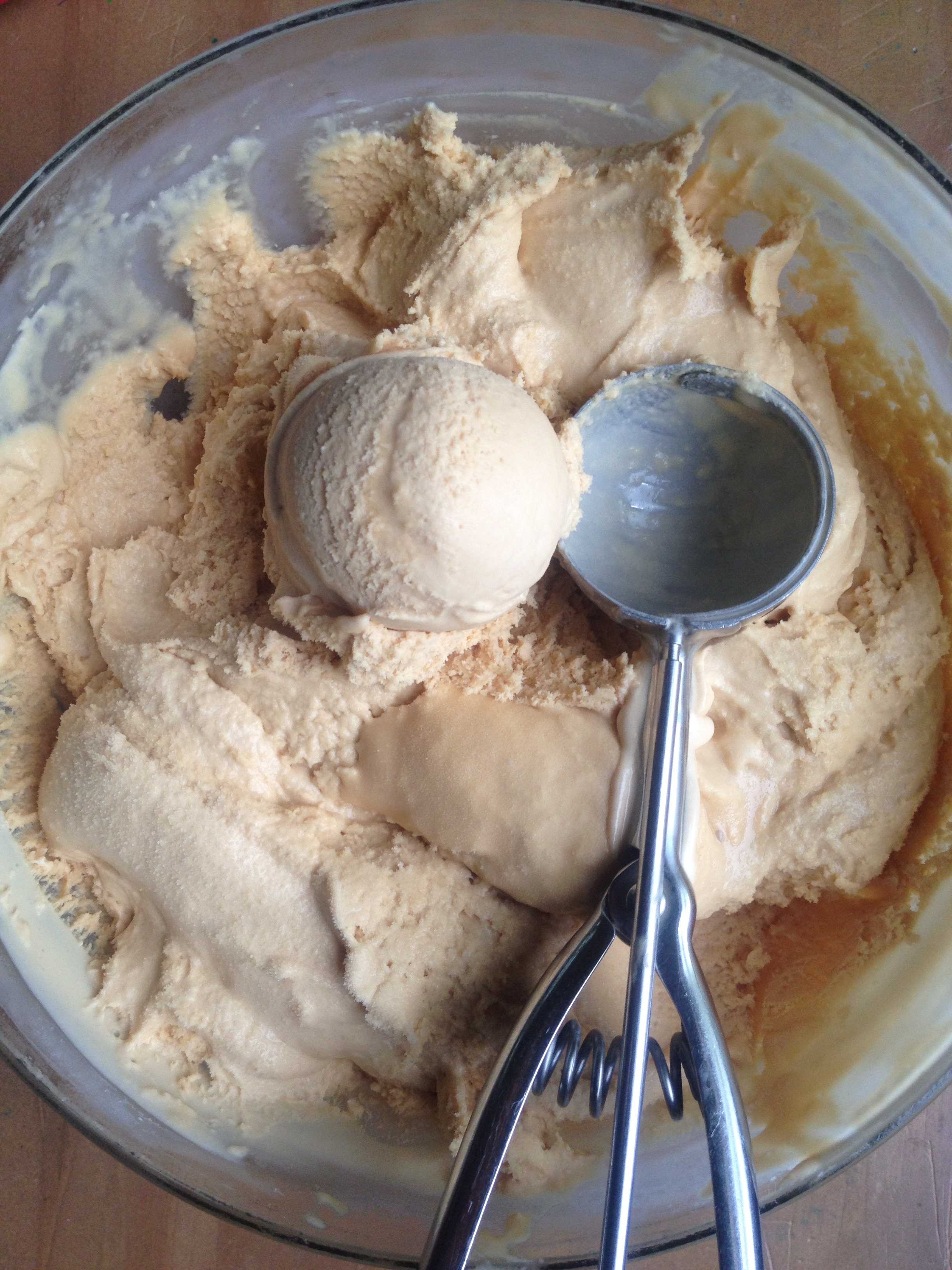I always thought that you needed an ice cream maker to make ice cream. Not so! I’m not saying this recipe is a completely casual undertaking, given the daredevil feat of making a dark amber caramel. But once that’s done, all you need are a pan and a fork and a bit of freezer space to produce a perfectly creamy scoop of Molly Moon’s salted caramel ice cream at home.
I remember a time, not so long ago, when it was more difficult to stumble across an ice cream shop on Capitol Hill. Hard to believe, maybe, now that they seem to be on every corner, but it’s true. I imagine that all of you began making your own ice cream at home in those dark days, as did I, and I see no reason to stop just because we now have so many excellent ice cream purveyors in the neighborhood. As everyone knows, there’s no such thing as too much ice cream.
Luckily, just in time for summer, the new Molly Moon’s Homemade Ice Cream cookbook makes this salted caramel recipe, and many others, available to home cooks on Capitol Hill and beyond. The book has all the classic and quirky flavors you’ve come to expect of Molly Moon’s. Scout mint? Check. Baby beet sorbet? Indeed. Honey lavender? Oh, yes.
But salted caramel is the shop’s iconic flavor, far and away the most popular. And after making a batch of it this week, I was reminded of why it’s such an enduring favorite. (Not YOUR favorite yet? A perk of making it at home is that you can control the darkness of the caramel and the amount of salt. I highly recommend following the recipe as written, but nobody will know if you want to dial it down a bit in the privacy of your own home.) So whether you have a fancy ice cream maker or just a fork, this recipe is for you. Salted caramel ice cream for the masses.
Salted Caramel Ice Cream
Adapted from Molly Moon’s Homemade Ice Cream (makes 1 to 1 ½ qts.)
1/8 tsp. freshly-squeezed lemon juice
1 ½ c. sugar
1 Tb. butter
3 c. heavy cream
1 c. whole milk
1 Tb. kosher salt
 Have your ingredients measured and beside the stove before you start making your caramel (except for the salt, which you add later). Put the lemon juice in a light-colored, heavy-bottomed pot and turn the heat to medium-high. Add the sugar ¼ c. at a time, stirring each addition with a wooden spoon until it dissolves completely into liquid. (Some of the sugar may crystalize on the side of your pot, just ignore it.) When all the sugar is added and dissolved, continue to cook, watching like a hawk and stirring occasionally for about 4-6 minutes. During this time, the sugar will caramelize and the color will change from a light golden to a dark amber hue (it may also begin to smoke a bit). Use your eyes, nose, and good sense to decide when you have achieved a dark-but-not-burnt caramel, and immediately lower the heat to medium-low as you trade your wooden spoon for a whisk and whisk in the butter.
Have your ingredients measured and beside the stove before you start making your caramel (except for the salt, which you add later). Put the lemon juice in a light-colored, heavy-bottomed pot and turn the heat to medium-high. Add the sugar ¼ c. at a time, stirring each addition with a wooden spoon until it dissolves completely into liquid. (Some of the sugar may crystalize on the side of your pot, just ignore it.) When all the sugar is added and dissolved, continue to cook, watching like a hawk and stirring occasionally for about 4-6 minutes. During this time, the sugar will caramelize and the color will change from a light golden to a dark amber hue (it may also begin to smoke a bit). Use your eyes, nose, and good sense to decide when you have achieved a dark-but-not-burnt caramel, and immediately lower the heat to medium-low as you trade your wooden spoon for a whisk and whisk in the butter.
When the butter has melted, begin to add the cream and milk verrrry sloooowly. Seriously, slowly. The caramel will steam and bubble and some hard little caramel lumps may form. No worries, keep whisking, be patient, let them dissolve. When the mixture is smooth, remove it from the heat. Pour it into a shallow pan and refrigerate until thoroughly chilled, at least an hour.
Remove the cold creamy pan of deliciousness from the refrigerator and whisk in 1 Tb. (yes, 1 Tb.) kosher salt. Process in an ice cream maker according to the manufacturer’s instructions (I churned mine longer than a usual batch, about 35 minutes, because the salt makes this ice cream so soft). Or if you don’t have an ice cream maker (or if it’s busy churning another flavor already), leave the mixture in the pan and transfer the pan to the freezer. If you’re going the no-ice-cream maker route, stir the mixture thoroughly with a fork every half hour or so until the entire pan of ice cream is a uniform texture (at first it will freeze around the edges, then you will stir it up, then it will freeze around the edges again, etc.).
When your ice cream is ready (it will still be quite soft), transfer it to a sealed freezer container and freeze at least four hours before serving. This ice cream never freezes very hard because of the salt content, so plan to serve and eat it quickly!
Note 1: I thought that the saltiness of this ice cream was perfect. If you find the finished product too salty-tasting, however, serve it over a rich brownie or under a blanket of hot fudge. Now it’s perfect, right?
Note 2: This magic no-ice-cream-maker method works better with this recipe than with others I’ve tried it with. Just a heads up in case you plan to use this method with other recipes: it always works, but usually the texture of ice cream made with the fork-and-pan system is icier/grainer than ice cream made with an ice cream maker. With this recipe, however, the results were indistinguishable.
Capitol Hill Cooks is a home cooking recipe series featuring ingredients, ideas, and recipes from the neighborhood. Have a recipe you think we should share? Drop us a line at [email protected]. Em also writes about home cooking at emmycooks.com
Previous Capitol Hill Cooks Posts




That seems such a scant amount, I think it would evaporate quickly, and wouldn’t provide enough liquid to help the sugar carmelize.
I claim no expertise when it comes to the magic of making caramel, but my understanding is that sugar can be caramelized without additional liquid (this is called making a “dry” caramel) or with additional liquid (“wet” caramel). Adding a small quantity of lemon juice helps to prevent re-crystallization of the sugar; some recipes call for as little as “a drop.” The recipe as written worked like a charm for me and, in case I didn’t stress this enough above, was seriously delicious. :)
Thanks for the response. I’ve only made caramel that was used in a creme caramel, which is a wet caramel. So I was wary of this dry method. My initial thought was it should read 1/8 cup lemon juice, but your explanation of just a drop of lemon juice allays all of my fears. I appreciate your responding to my query.
Would this recipe work out in an ice cream machine?
Sorry, I didn’t bother reading through the entire recipe before I asked questions. I see where you used one for 35 minutes. I was focusing on the fork and pan method and my eyes must have totally skipped that bit.